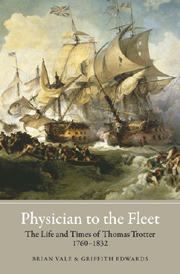Book contents
- Frontmatter
- Contents
- List of Illustrations
- List of Abbreviations
- Foreword
- Preface
- Background
- From Surgeon's Mate to Physician to the Fleet
- 3 HMS Berwick
- 4 Surgeon of a Slaver
- 5 Northumbrian Interlude
- 6 Recalled to the Colours
- 7 The Royal Hospital, Haslar
- 8 Physician to the Channel Fleet
- 9 The Conquest of Scurvy
- 10 Shore-Based in Plymouth
- 11 Honours and Half-Pay
- The Newcastle Years
- Bibliography
- Index
7 - The Royal Hospital, Haslar
from From Surgeon's Mate to Physician to the Fleet
Published online by Cambridge University Press: 12 September 2012
- Frontmatter
- Contents
- List of Illustrations
- List of Abbreviations
- Foreword
- Preface
- Background
- From Surgeon's Mate to Physician to the Fleet
- 3 HMS Berwick
- 4 Surgeon of a Slaver
- 5 Northumbrian Interlude
- 6 Recalled to the Colours
- 7 The Royal Hospital, Haslar
- 8 Physician to the Channel Fleet
- 9 The Conquest of Scurvy
- 10 Shore-Based in Plymouth
- 11 Honours and Half-Pay
- The Newcastle Years
- Bibliography
- Index
Summary
HMS ‘Vengeance’
VENGEANCE arrived in Portsmouth after a wet and stormy trip from Chatham packed with men. In addition to her normal complement of six hundred, she carried another four hundred who were to be distributed to other ships in the squadron, and when Trotter joined her in February 1793, large numbers had been laid low with typhus. Sixty of the most serious cases were transferred to Haslar, while dozens remained sick on board. Trotter took stringent action to isolate the infected, fumigate the atmosphere, dry the decks with stoves and fires, pump out the hold, cleanse the ballast and ensure that the crew, their clothing, bedding and hammocks were clean and washed with soap. It took a month before the outbreak had been contained and the ship was ready for sea.
On 10 March 1793, Vengeance sailed with orders to escort a convoy to Cork, then to join a squadron under Rear Admiral Alan Gardner off the Scilly Isles. The ship reached her rendezvous point on 24 March. Alas, she arrived too late: Gardner's force had passed the Scillies twenty-four hours earlier. Thompson waited for a week then returned to Portsmouth. Vengeance eventually left for the West Indies on 16 April as escort to an outward-bound convoy, and reached Barbados after an uneventful voyage on 11 June. Once again she was too late. Gardner's squadron was already off Martinique and the following day landed a mixed force of British and French royalist troops to attack the local republicans.
- Type
- Chapter
- Information
- Physician to the FleetThe Life and Times of Thomas Trotter, 1760–1832, pp. 86 - 95Publisher: Boydell & BrewerPrint publication year: 2011



